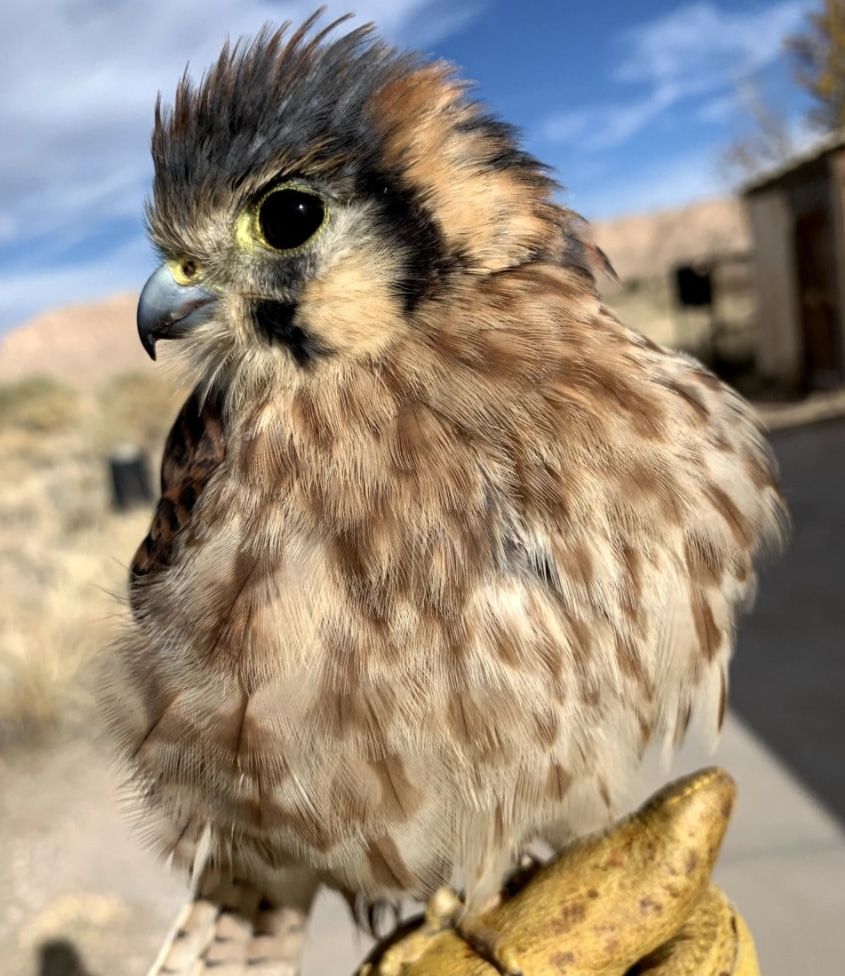 Amelia, the American kestrel/animal ambassador. Courtesy/NMWC
Amelia, the American kestrel/animal ambassador. Courtesy/NMWC
By LINDA HULL
Vice President
Rotary Club of Los Alamos
“Before you rescue any baby birds or baby animals, please call a certified wildlife specialist,” advised Chase Spearing, Education Coordinator for the New Mexico Wildlife Center (NMWC), when she spoke from Española by Zoom to the Rotary Club of Los Alamos April 27.
“Most animal parents are nearby and will take care of the babies we might think are abandoned,” Spearing said.
NMWC, founded in 1986 by veterinarian Dr. Kathleen Ramsay, moved to its current location just south of Española in 2005. The Center has just welcomed new director Matthew Miller. He joins an enthusiastic staff that is committed to the NMWC’s mission “to connect people and wildlife for an abundant tomorrow.”
As Spearing explained, the NMWC has two different lines of operation: the wildlife hospital and the wildlife education program. The wildlife hospital is open year-round. In addition to one full-time veterinarian, hired through a grant, and two wildlife rehabilitators, four interns will join the staff during the busy summer months ahead. In 2020 alone the NMWC took in more than 1,000 injured animals, most of which were released again to the wild after successful treatment.
In March, the year’s first baby animal admission to the hospital was an orphaned Eurasian Collared-Dove nestling. The NMWC does not treat or rehabilitate bears or mountain lions, but can accept birds and New Mexico’s smaller animals, such as rabbits, mice, raccoons, foxes, bobcats, coyotes, deer, snakes and turtles.
Spearing stressed always to call a licensed wildlife rehabilitator prior to offering wild animals any assistance.
The hospital and the education program work together closely. Animals whose injuries are so debilitating that they cannot be returned to the wild are housed in enclosed habitats on the NMWC’s 20-acre grounds as are other animals who are “too human-familiar” and must rely on people for their care.
These animals become Animal Ambassadors who visit area classrooms in person or by Zoom to help educate the public about New Mexico wildlife. Most of these animals are birds of prey with some reptiles and mammals.
Animal Ambassador Amelia, an American kestrel (Falco sparverius), was Rotary’s guest.
Amelia cannot be returned to the wild because she has been imprinted too strongly by humans and has “never learned how to live as a self-sufficient kestrel,” remarked Spearing. A small falcon, kestrels are surprisingly powerful. They have forward-facing eyes, powerful beaks, and prey upon insects, small rodents, and other birds. They are one of the most common falcons in the United States and can be found in deserts, grasslands, and alpine meadows, preferring to hunt where trees do not obstruct their vision. They sport large eye-like patterns on the backs of their heads to act as “eyes on the back of their head” to deter being ambushed by larger predators. As Spearing spoke about kestrels, Amelia trilled while comfortably perched on the gloved hand of NMWC site manager and volunteer coordinator Jessica Schlarbaum.
Spearing concluded with a reminder to call the NMWC before approaching or rescuing wild animals and asked that the public refrain from tree trimming “now through the summer. You never know whose nest you’ll disturb.”
The New Mexico Wildlife Center, located at 19 Wheat Street in Española, is open to visitors, Monday-Saturday, 9 a.m. to 4 p.m.; wildlife hospital hours are Sunday-Monday, 9 a.m. to 4 p.m. For more information and to inquire about volunteering, please go to: https://newmexicowildlifecenter.org/
From a very young age, guest speaker Chase Spearing had “a passion for animals of all shapes and sizes,” although she confesses spiders still do give her “the shivers.” She spent most of her childhood in Santa Fe, but her family later moved to Oregon. In high school, she spent her summers teaching youth science camps in the foothills of the Cascades. That passion for the sciences led her to Portland State University (PSU) where she earned her Bachelor’s of Science degree in biology. One of her favorite courses, and most challenging, was ornithology, through which she developed a love for birds she had never expected.
After graduating from PSU, Spearing’s interests in birds of prey and in wildlife education took her to a wildlife rehabilitation and education center in southern Oregon. There she worked extensively with the raptor collection. She says a small owl named Boris and a vulture named Aurora hold special places in her heart.
In addition to raptors, Spearing also assisted with the care of bears, wolves, mountain lions, badgers, and other animals. Her favorite memories from her work in southern Oregon are the opportunities she had “educating people and bringing animal ambassadors to public events to inspire a passion for wildlife both locally and globally.”
The Rotary Club of Los Alamos, through its Club Foundation, is a 501(c) 3 non-profit and one of over 34,000 clubs worldwide. Rotary, which now has 1.5 million members, was founded in 1905; the local Club was chartered in 1966. Rotary areas of focus, as noted in above, include promoting peace; fighting disease, particularly polio; providing clean water, sanitation, and hygiene; supporting education; saving and enhancing the lives of mothers and children; growing economies; and protecting the environment.
To learn more about the Rotary Club of Los Alamos and humanitarian service, contact President Laura Gonzales at 505.699.5880 or Membership Chair Skip King at 505.662.8832.

